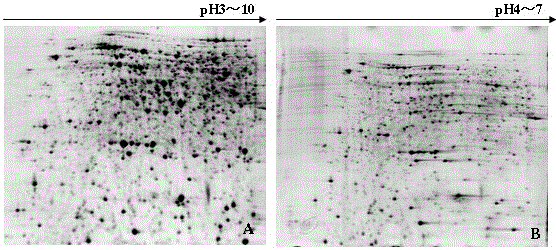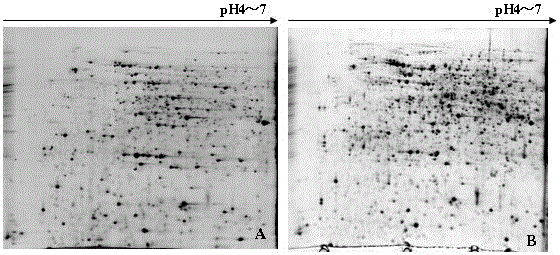A method for the analysis of pulp proteome in muskmelon
A thin-skinned melon and proteome technology, which is applied in the field of proteome analysis of horticultural crops, can solve problems such as lack of research, and achieve good repeatability, simple operation, and clear maps
- Summary
- Abstract
- Description
- Claims
- Application Information
AI Technical Summary
Problems solved by technology
Method used
Image
Examples
Embodiment 1
[0026] Thin-skinned muskmelon proteome analysis method of the present invention is specifically as follows:
[0027] 1. Protein extraction
[0028] Weigh about 1 g of the flesh of thin-skinned melon (Jingmi No. 11), grind it into powder in liquid nitrogen, and add 3 ml of Tris extract to the mortar (Tris extract formula: 50 mmol / L Tris, 50 mmol / L EDTA, 100 mmol / L potassium chloride, 2% DTT, 30% sucrose, 1mmol / L PMSF, the rest is water), after it melts, continue to grind for 3~4min, transfer to a centrifuge tube, add an equal volume of pH8.0 Tris - Saturated phenol, vortex, and centrifuge (10000 × g, 4°C) for 10 min. Take the phenolic layer, add an equal volume of Tris extract to the phenolic layer for extraction twice, add about 5 times the volume of 0.1 mol / L ammonium acetate methanol solution to the phenolic layer, and precipitate at -20°C for more than 2 hours. Centrifuge (15000 × g, 4°C) for 20 min, discard the supernatant, wash the precipitate once with -20°C pre-cooled...
Embodiment 2
[0046] The difference between this example and Example 1 is that the gel strip used in the isoelectric focusing step is a 24 cm strip with a pH of 3-10, the loading amount is 500 μg of protein, and the rest are the same as in Example 1. After isoelectric focusing electrophoresis , see the spectrum of gel vertical electrophoresis figure 1 a.
Embodiment 3
[0048] The difference between this example and Example 1 is that the gel strip used in the isoelectric focusing step is a 24 cm strip with a pH of 4-7, the loading amount is 500 μg of protein, and the rest are the same as in Example 1. After isoelectric focusing electrophoresis , see the spectrum of gel vertical electrophoresis figure 1 b.
[0049] Comparing Example 2 with Example 3, it can be seen that the strip is a 24cm strip with a pH of 4-7, and the protein spots are completely separated, mostly round or oval, without horizontal or vertical lines (see figure 1 ).
[0050] Comparing Examples 1 and 3, it can be seen that when the loading amount is 800 μg protein, the map is clear, there are many protein spots and the gray level is high (see figure 2 ).
PUM
| Property | Measurement | Unit |
|---|---|---|
| volume | aaaaa | aaaaa |
Abstract
Description
Claims
Application Information
 Login to View More
Login to View More - R&D
- Intellectual Property
- Life Sciences
- Materials
- Tech Scout
- Unparalleled Data Quality
- Higher Quality Content
- 60% Fewer Hallucinations
Browse by: Latest US Patents, China's latest patents, Technical Efficacy Thesaurus, Application Domain, Technology Topic, Popular Technical Reports.
© 2025 PatSnap. All rights reserved.Legal|Privacy policy|Modern Slavery Act Transparency Statement|Sitemap|About US| Contact US: help@patsnap.com


